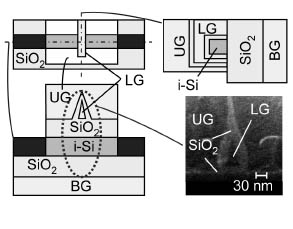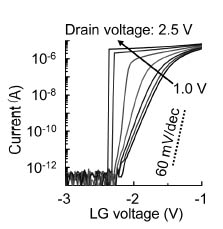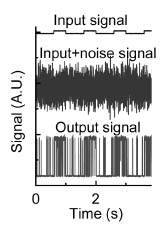Physical Science Laboratory
A field-effect transistor (FET) is a device to amplify
signals applied to a gate terminal, which can be used for a sensor with
a high charge sensitivity. To maximize the sensitivity, current characteristics
as a function of gate voltage should be as steep and as non-linear as possible.
However, steepness or subthreshold swing (SS) of current characteristics
is fundamentally limited by thermal fluctuation, e.g., 60 mV/dec at room
temperature. On the other hand, practical use of the sensor necessitates
suppression of outside noise masking an output signal from the FET. In
this work, we demonstrate detection of a signal buried in noise with a
transistor having extremely small SS [1].
The device is composed of a wire channel covered with
three gates as shown in Fig. 1 [2]. An upper gate (UG) and back gate (BG)
is used to induce a source and drain electrically. Then, current is modulated
by a lower gate (UG) as in a conventional LG. When drain voltage is large
enough to induce hot electrons, they generate electron-hole pairs due to
impact ionization. Generated holes flow in a body region of the channel
and thus amplify electron current, which lead to further impact ionization.
This positive feedback makes current characteristics steeper
and SS reaches ~1 mV/dec regardless of thermal fluctuation (Fig. 2).
Detection of signal buried in noise is performed by using stochastic resonance (SR), which is a unique phenomenon that takes advantage of noise to enhance the response of a system to a weak signal [3]. Non-linear current characteristics of the FET enable SR to provide a correlation between the noise-buried input and output current signals. It is confirmed experimentally and theoretically that stronger non-linearity, i.e., small SS, and bistability of current characteristics boost an effect of SR (Fig. 3). Moreover, the dynamic bistability enables SR effect to be enhanced by adding common noise to multiple FETs. The FET providing such unique characteristics opens the way to use SR for practical applications.
This work was partly supported by the Funding Program
for Next Generation World-Leading Researchers of JSPS (GR103)
[1] K. Nishiguchi and A. Fujiwara, Appl. Phys. Lett. 101 (2012) 193108.
[2] K. Nishiguchi and A. Fujiwara, Appl. Phys. Express 5 (2012) 085002.
[3] L. Gammaitoni et al., Rev. Mod. Phys. 70 (1998) 223.
 |
 |
 |
||||||||
|
|
|